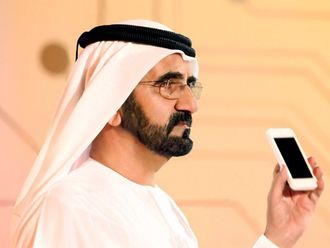
Dubai: Panasonic Corporation expects its Middle East operations to post 30 per cent growth in revenues this fiscal year as it continues its transformation from an electronics company into a more diversified group, Kazuhiro Tsuga, president of the Japanese company, told Gulf News in an exclusive interview.
The Japanese company has chalked out its growth strategy for the next three years in bid to cut its reliance on consumer electronics and focus more on business-to-business segment.
Tsuga said that B2C is still a strong market in the Middle East but some of our product portfolios are still missing in the region. Now, Panasonic will come with its full product line-up from small to major appliances.
“We are developing our new business model, implemented in India, to collaborate with Chinese manufacturers and vendors and have already launched some missing products in India. The same business model will be applied in the region,” he said.
Last year, the company achieved 10 per cent growth in the region.
He said that the company is interested in merger and acquisition deals and has set aside one trillion yen for strategic investment till 2018, out of which half will be for M&A deals.
The company made huge losses in 2011 and 2012 and was forced to restructure its business and divisions.
He said that radical steps were needed to save the Japanese company, and the restructuring efforts are bearing fruit now.
“In 2012, we made a three-year midterm plan to make an operating profit and free cash flow. Fortunately, we achieved that numbers in two years,” he said. Panasonic returned to profitability in fiscal 2014.
The company celebrates 100 years in 2018.
Panasonic ‘s annual profits soared 49 per cent to 179.49 billion yen, owing to strong results at its lesser-known auto parts unit and lower costs linked to a sweeping restructuring and revenues touched 7.7 trillion yen.
The company’s target is to achieve 10 trillion yen in 2019 and Tsuga is confident of achieving it. This fiscal year the company expects eight trillion yen.
“Now we are looking for the next decade of sustainable growth. Putting our DNA in consumer electronics as the centre, we are trying to extend our business to automobiles, aviation, housing, cloud and B2B solutions,” he said.
B2B segment contributes 75 per cent to the group’s total revenues.
Currently, Japan is still the main market for the company and contributes 48 per cent to its total sales and the rest from overseas. Out of the 52 per cent overseas market share, around fifty per cent comes from America and Europe and the other 50 per cent comes from strategic regions like China, India, Africa and Middle East.
He said the strategic regions are still a main market for consumer electronics but US, Japan and Europe are going to be stagnant.
Panasonic, once known for its Plasma TV, is struggling in the TV business along with other Japanese manufacturers and facing immense competition from the Korean brands.
“Yes, TV sales volume is decreasing, it is OK. But we have more areas for growth, like housing and automotive, and have 37 business divisions. We have decided not to exit the TV business and will continue,” he said.
Tsuga, an admitted car buff and head of Panasonic’s automotive division earlier, said that the automotive segment sales will double in the next five years.
The TV segment is still facing “stiff competition”. Technology wise, it has already been saturated.
“What is happening is that even though Korean players have high market share, it is not profitable. And Chinese makers are coming heavily. We do not want to actually fight with China TV manufacturers and I see no meaning in that. We have lots of more areas to contribute to the society or people,” he said.
The TV will not just be the “receiving device” for the TV broadcasters but it will become the display device in future.
“So, we have to think carefully how TV will be used, kept in the house, on top of a table or on the wall. Will large TV be required; all these things will have to be studied carefully.”
Even though the devices segment (PCs, TVs, smartphones) is going to be small, he said the device knowledge will be shifted to higher layers of consumer electronics segments like housing, automotive and B2B solutions.
Regarding automotive, he said that Panasonic is now trying to change car automotive itself from many point of view. The electrification, safety, energy point of view inside the car is totally changing.
“We can provide sub system for all. So, in a way it is a very big innovation. On the battery side, you know, we work together with Tesla to make Giga factory. That’s a big innovation,” he said.
The company is currently working all the carmakers around the globe for connected cars and is now a battery supplier for Tesla Motors’ Model S vehicle and has since constructed a major battery manufacturing factory in the US.
With Japanese consumer electronics manufacturers facing pressure in its home country, they are looking at overseas for growth.
In general, he said that the growth area comes from outside Japan, that’s for sure. But still we have lots of opportunities to expand Japanese business.
“Yes, we are looking at acquisitions for growth. Till 2018, we have earmarked one trillion yen in strategic investment and out of that 50 per cent will be for acquisitions.
The company still sees Japan as a major market for consumer electronics amid shifting from B2C to B2B. The market share of Panasonic in the Japanese consumer electronics market is 30 per cent.











